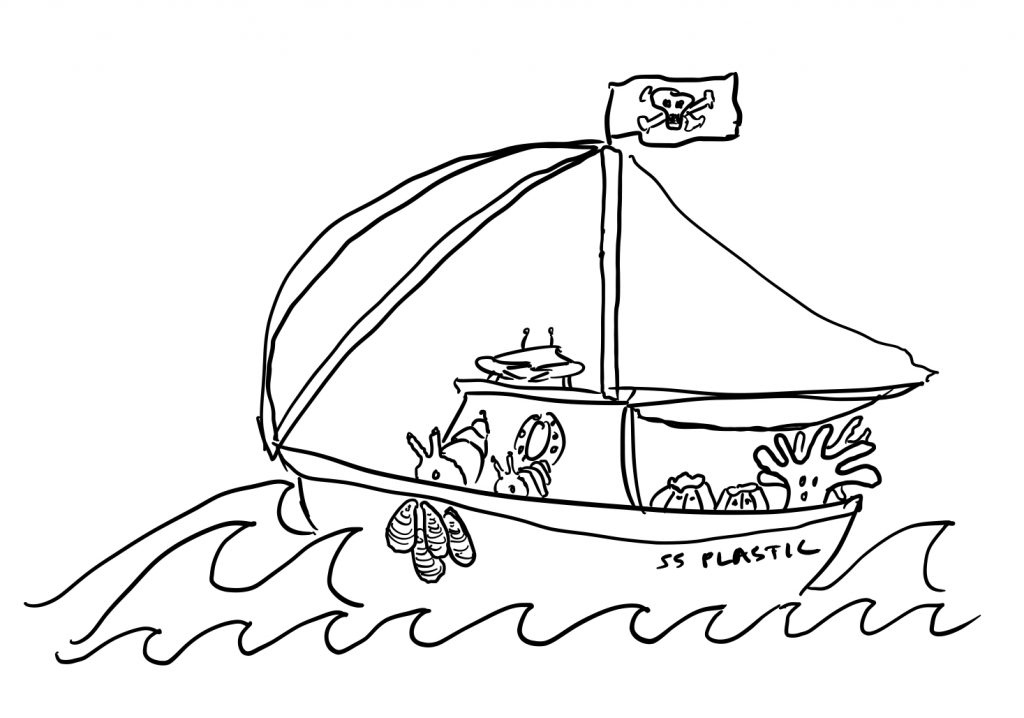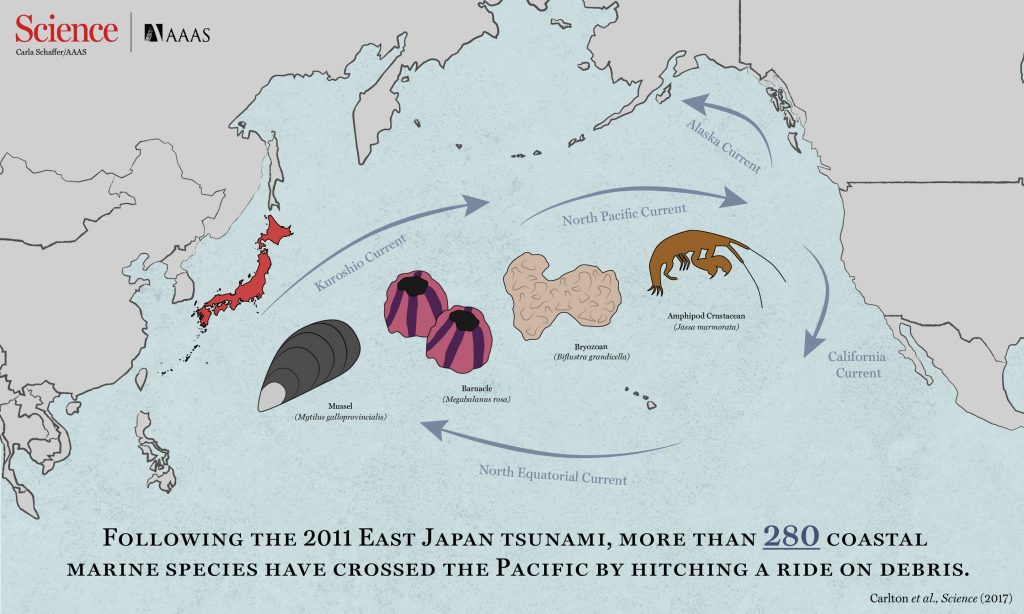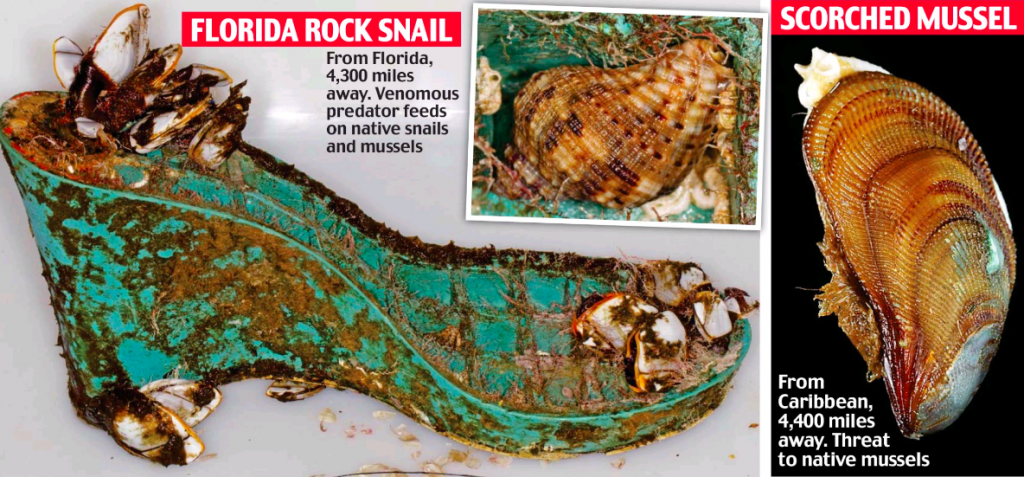For millions of years, animals and plants have sailed the high seas, colonizing islands and even continents across vast oceans. Natural rafts have dispersed many different biota and have been included in hypotheses, to explain the biogeography of disjunct distributions of creatures all around the world, from insects and frogs to monkeys (3).
But in recent years, there have been technological advancements for these transoceanic travelling species, allowing them to travel longer and further than ever before… Our garbage. Yes, the increase in use of plastics and other manufactured materials, that take centuries to decompose, are the new trendy lifeboats for opportunistic (and resilient) species all around the world. And the rate to which these hitch-hikers are finding land is increasing, with more rafts readily available for sail.

The journal Science reported that every year, between 4.8 to 12.7 million tonnes of plastics are dumped into the ocean, this was the result of a study in 2015 (2). In 2011, a large tsunami hit the coast of Japan, resulting in around 20 million tonnes of debris sucked out to sea (6). A devastating disaster for the country, resulting in a massive influx of anthropogenic raft material, for many organisms from Japan to be passively taken with…

Most of these animals, able to withstand living in the open ocean for months, if not years, are molluscs, tube worms, jellies, bryozoans, and crustaceans, usually with cosmopolitan ranges (7). This is one example from Japan to North America, resulting in conservationists and ecologists, scrambling to identify the potential threat of these species, which seem to thrive in these new environments, many other countries face the increased onslaught of these pirate-like, invasive species.
In another ocean, these hitch-hiking sea-goers face the treacherous waters of the Atlantic, and are washing up all over Britain’s shores, clinging onto their plastic boats. Many of these invasive species are coming from the tropics and Florida, and travelling by the Gulf stream, which is causing scientists to wonder how these species are surviving and reproducing in much colder environments(5). One species of concern is the Florida rock snail, which has the potential to cause some real damage to the native ecosystem, because of its predatory behaviour, feeding on native muscles and snails (1).

So we’re seeing these creatures can travel pretty far… but how far exactly? For instance, what about Antarctica? Previously thought, Antarctica has been considered as ecologically isolated from the rest of the world, due to the Southern Ocean’s strong winds, ocean currents and other physical barriers (4). But a recent discovery of a species of kelp, carrying populations of epifauna, was found to have rafted 20,000 km (the longest recorded rafting event) from mid latitudes to Antarctica’s shore. This rafting event is opening up scientist’s eyes to the possibility of more species being able to access this not so isolated ecosystem. Not only are they able to cross this trek of water, but with global warming, the likelihood of these events is to increase and potentially allow a more diverse establishment of organisms (4).
“Every piece of science he knew said that this species of kelp should never have ended up in Antarctica.” – The Conversation, Erasmo Macaya
While this study only looks at the biological floating material and its impacts on Antarctica’s ecosystems, its likely that in the future, where climate models have projected Antarctic coasts to warm significantly, will be in a state of a dynamic shift from the native species to newly established species (4).
We see our plastics have begun to spread species across the highly populated mid-latitudes, but will we also see this begin in more isolated regions? And are we going to do anything about it?
It appears in these few articles, that the only solution proposed to stop these plastic riding invaders, is to reduce overall plastic use AND create regulations for oceangoers (fishers, tourists, etc) ensure that they bring back everything, instead of leaving it to the ocean.
References:
- Butterworth, B. Record numbers of invasive species are being swept to Britain’s shores on plastic litter. iNews: The Essential Daily Briefing [internet]. 2019 Jan 7 [cited 2019 Feb 12]. Available from: https://inews.co.uk/news/environment/record-numbers-invasive-species-britain-shores-plastic-litter/
- Carlton JT, Chapman JW, Geller JB, Miller JA, Carlton DA, McCuller MI, Treneman NC, Steves BP, Ruiz GM. Tsunami-driven rafting: Transoceanic species dispersal and implications for marine biogeography. Science. 2017 Sep 29;357(6358):1402-6.
- De Queiroz A. The resurrection of oceanic dispersal in historical biogeography. Trends in ecology & evolution. 2005 Feb 1;20(2):68-73.
- Fraser CI, Morrison AK, Hogg AM, Macaya EC, van Sebille E, Ryan PG, Padovan A, Jack C, Valdivia N, Waters JM. Antarctica’s ecological isolation will be broken by storm-driven dispersal and warming. Nature climate change. 2018 Aug;8(8):704.
- Hayward, E. UK sealife at risk from species swept here on plastic litter. Daily Mail [internet]. 2019 Jan7 [cited 2019 Feb 12]. Available from: https://www.dailymail.co.uk/news/article-6562907/Native-UK-sea-life-risk-invasive-species-swept-plastic-litter.html
- Paterson, S. Japan’s tsunami debris: Five remarkable stories. BBC News [internet]. 2016 Mar 9 [cited 2019 Feb 12]. Available from: https://www.bbc.com/news/world-asia-35638091
- Pipkin, W. Invasive Species Are Riding on Plastic Across the Oceans. National Geographic [internet]. 2018 Aug 28 [cited 2019 Feb 12]. Available from: https://www.nationalgeographic.com/environment/2018/08/news-invasive-species-ride-plastic-across-ocean/
 Follow
Follow